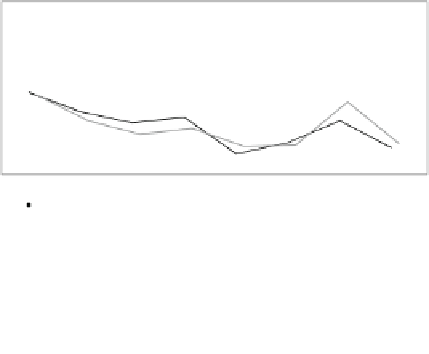Geography Reference
In-Depth Information
Four individual landmarks showed statistical significance when testing the
differences in use frequencies between day and night among the participants:
they used “footpath” (median difference 0.9 pps,
p
0.05; no difference in number
of users) more during the day and “boulder” (1.9 pps,
p
¼
¼
0.01; 6 users more),
“standing rootstock” (1.2 pps,
p
¼
0.005; 6 users more) and “streetlamp” (0.9 pps,
p
0.008; 2 users more) more at night. “Footpath” gained more attention during the
day, probably due to its greater presence in the field of view, which was restricted at
night. “Streetlamp” was noted more frequently at night, often distantly, due to its
emission of light. “Boulder” and “standing rootstock” were probably more salient
when seen in the spotlight than in daylight.
“Passages” and “Signs” were the two most used landmark groups for both day
and night conditions, but in different order (Fig.
2
). “Structures” was the third
largest group in both conditions, while “Rocks” was the least used in both cases.
The ranks of the landmark groups reflect the route and its environment: “Passages”
was frequently used due to the route running on passages, and “Signs” were present
all along the route to guide walkers. The higher use frequency of “Signs” compared
to “Passages” at night was probably caused by the higher visual salience of signs in
the spotlight of the headlamp.
The two-way permutational multivariate ANOVA resulted in significant main
effects for both the time of day (
F
¼
2.92,
p
0.03) and task (
F
26.99,
p
0.001).
¼
¼
¼
<
No significant interaction effect occurred (F
0.99). Consequently, we
continued statistical analyses using univariate Wilcoxon tests, in which two land-
mark groups among eight scored statistical significance for the differences of
0.00,
p
¼
¼
0.5
0.4
0.3
0.2
0.1
condition
day
night
0.0
0.5
0.4
0.3
0.2
0.1
0.0
Landmark group
Fig. 2 Comparison of the relative frequencies of the landmark groups between day and night. The
error bars
depict a 95 % confidence interval for percentile bootstrap medians









































































































































































